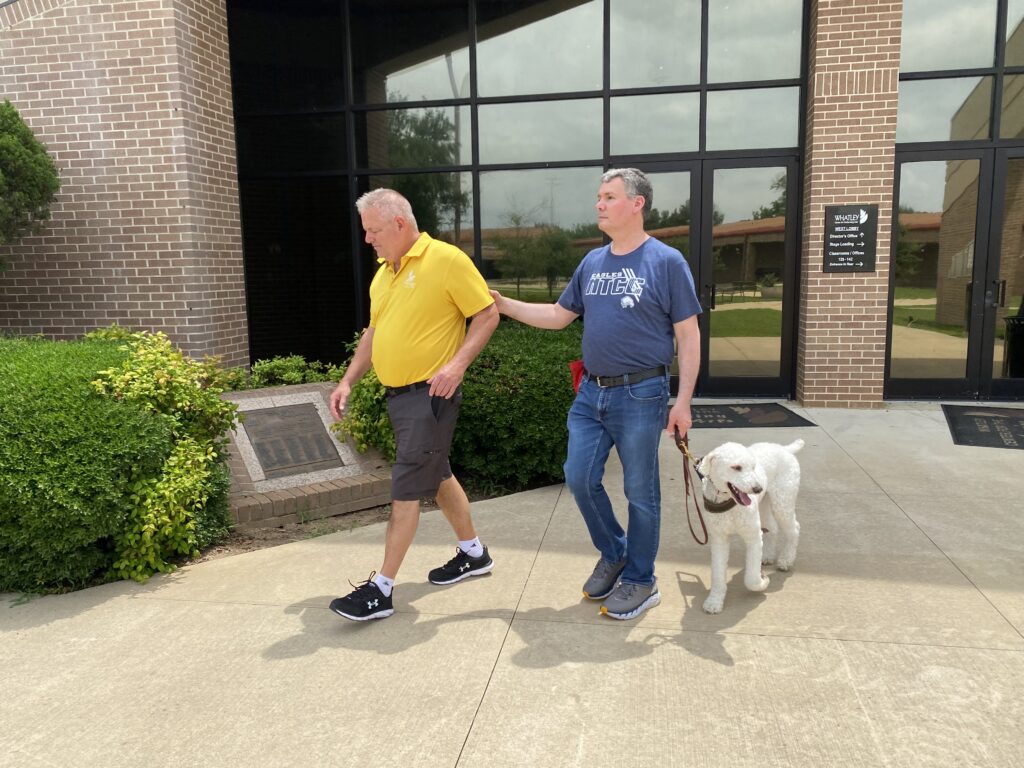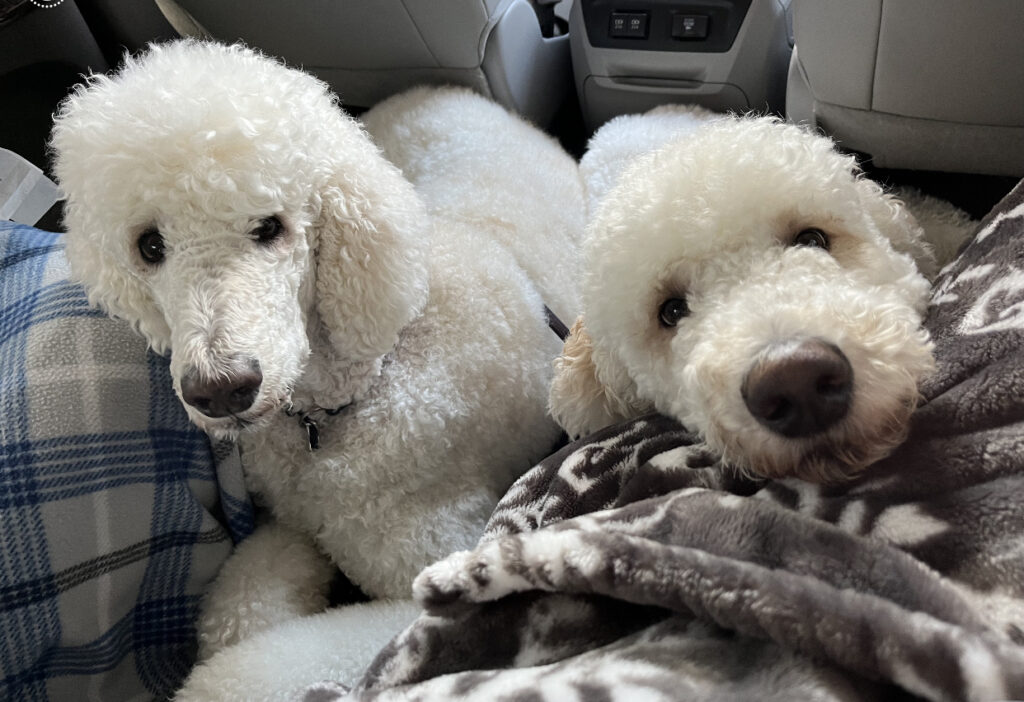Professor’s dog retires

By Ian Griffin
Staff Writer
Anyone making their way around the Northeast Texas Community College campus over the past few years probably remembers seeing Adjunct History Instructor John Russo and his seeing-eye dog, which most of the faculty and staff affectionately referred to as the “Poodle Man.” Recently, however, some may have thought they were seeing double when Russo suddenly appeared on campus with not one, but two almost identical, white standard poodles.
So the question arises. Does “Poodle Man” have a twin? As is often the case, things are not always what they seem. Anyone taking a closer look might have noticed a slight difference between the two dogs. “Poodle Man” has a longer snout and is a bit taller than his counterpart. The other dog also has a younger appearance than Russo’s constant companion. The truth is that instead of being “Poodle Man’s” twin, the other dog is simply his successor.
After eight years of service, Russo’s seeing-eye dog retired this past summer, and a new service animal, trained by Pilot Dogs out of Columbus, Ohio, was brought in to take his place. The good news is that Russo and his wife, Cheryl, were allowed to keep his original service dog as a pet. So, does that mean the secret is out and the “Poodle Man’s” true identity could finally be revealed? For years Russo’s companion made his way around the NTCC campus incognito almost like a secret agent working under the guise of an alternate name. With the animal’s retirement from service last summer, his name could finally be known. Some folks may have been a bit surprised to learn that “Poodle Man” is actually just a dog named Rosco.
Russo said it was a bittersweet moment when he met his new service dog and realized that Rosco’s role was about to change.
“When I was at the guide dog school and faced the moment when the trainers tell you to go back into the room, and we will be bringing your dog to you, I had to hold back tears,” Russo said. “I thought, ‘You know this really is the end now because Rosco is retired and whoever this new dog is will take his place.’”
Russo said things became a little easier when he introduced the dogs and they quickly became fast friends. To ensure there were not any territorial issues between Rosco and Joey, he had the two dogs meet each other on the sidewalk instead of an area that Rosco had already established as his territory. The two dogs got a chance to get to know each other, and then they became instant buds from that initial meeting.

“Thankfully when I brought my new dog home, the two of them met and sniffed each other, and they was just like ‘Hey man, nice to meet ya’,’” Russo said. “They were so quick to adapt. It made it so much easier for me. I really did feel a sense of loyalty to my first dog, and it was kind of sad. But the two of them love each other. They lay together and they eat right by each other and every day, I mean every day, wherever I am, both of them are by my side.”
Russo recalled some of the early days when he first received Roscoe eight years ago and attended the training at Pilot Dogs. According to the company’s website, Pilot Dogs “Helps people who are blind or visually impaired achieve greater independence and mobility.” Their program is based on three phases of training, “Puppy Raising,” “Formal Dog”and the final phase, “Team Training.” Russo met Rosco for the first time during the Team Training phase of the process. Rosco had already completed six months of training before Russo showed up at Pilot Dogs to begin his training. After two days of lecture, Russo finally got to meet his new service dog.
“It is a bit of protocol. They will bring the dog into the room,” Russo explained. “ They want you to stay still as a statue, with no reaction because one of the basic instincts in the mind of the dog is dominance and submissiveness. That is the first instinctual concept they have. So, when they bring this dog to you, and it doesn’t know you, if it barks or growls or whimpers or anything like that and you respond, from its perspective you obeyed it, you’re submissive.”
Russo said it is important to make sure the dog quickly learns to obey its new owner’s commands. He had to make sure that Rosco followed his order to lay down before he did anything else with the animal.
“Once the dog lays down, it has demonstrated submission. Once it has done that, you can reach down, say its name, pet it,” he said. “The next thing you do is take the dog into the bathing facility and bathe the dog. They say that one of the most intimate ways to bond with the dog is to bathe it, groom it and brush it.”
Initially, Russo said he was reluctant to trust the dog during the training process. “One day, the instructor said to me, ‘Mr. Russo, the dog is certified. You are in training,’” he recalled. By the third day of training, however, the two had created what became the first moments of bonding that continues until this day.
Rosco and Russo’s new service dog, Joey, were trained specifically for the instructor’s needs. Not only to find the safest path to lead Russo safely where he needs to go, but the dog must be able to obey and disobey accordingly. Unlike other service animals, a seeing-eye dog must demonstrate intelligent disobedience. “This means the dog may be given a command to go, but the dog may see potential danger such as a passing car, and the dog will determine that it is not a good time to go, therefore intellectually disobeying the handler,” Russo said.
The level of maneuverability and travel changed for Russo once Rosco came into his life. Over the years, the dog has successfully guided Russo across campus, to his classrooms, in and out of restrooms, and various other places on campus. Russo said he even often interjected Rosco into his classroom activities. He said using the dog as a teaching tool helped add humor to the history class. Finding unique and creative vignette opportunities and inserting Rosco, and now Joey, into vignettes of the lecture helps break down barriers in learning for some students.
“I absolutely consider the dog as a partner,” Russo said. “I make jokes about him all the time…It adds to the comfort level in the classroom.”
He said his dog also serves as a calming and comforting effect for some of his students. While a service dog should not be petted while he is in his harness, Russo would often allow people to pet Rosco when he wasn’t working. “I had one student, who took three of my classes, and she frequently came by the office to pet the poodle,” Russo said. “She would ask to pet him, and I always would say yes.”
Russo said he didn’t realize just how much the dog’s presence meant to the student until she had transferred on to another school. “She sent an email to me just a couple weeks ago and asked how Rosco was doing? I said, “Oh nice, good to hear from you. How is life on your end?’ She responded and said, ‘That dog gave me so many moments of decompression. I used to look forward to petting that dog to relieve stress.’ Even after she was no longer in my classes, in a different semester I would hear a knock at the door. She would look in and say, ‘Can I pet Rosco? I need my poodle fix.’”
Although most people on campus did not know Rosco’s true identity, about two years into his service, he shared the dog’s real name with Humanities Administration Assistant Delbra Anthony, who had developed a bond with the dog. She often played with him in her office at times when Russo removed his harness. She said Rosco’s retirement was sad, but she understood that his body was aging and it was time.
“I had such an interaction with Rosco, and I knew that Rosco didn’t want to retire, he still wanted to work,” Anthony said. “When John and Rosco would come into the building, Rosco would look into my office to see if I was here, and then he would take John on to his office.The relationship that Rosco and I developed in those first the years, he was like one of my dogs, only he just visited me here instead of at home. I was sad to see him go.”
The logic behind keeping Rosco’s true identity from the campus community was not sinister. Since Russo is blind, it was suggested by the trainers at the time that the dog’s name remain unknown by anyone but his owner. Withholding his real name ensured that only the dog’s owner would be able to call out to the dog. This prevented Russo’s service animal from becoming distracted and potentially leading him into harm’s way.
As Rosco neared retirement, Russo traveled back to Pilot Dogs Ohio last May to train and pick up his new service dog. Russo discovered that the training procedures had changed some over the past eight years. It was now advised not to give the dog an alias but instead let people know the animal’s real name. This change requires some responsibility from the community, who are still asked to allow only the handler to say the dog’s name. This practice is to prevent any confusion for the dog. With that understanding, Russo is openly sharing the new dog’s name with the campus.
The bond that developed between Russo and his first seeing-eye dog, Rosco, continues to be immeasurable. The dog has now moved on from his service to simply enjoy a peaceful life with Russo and his wife. Shortly after the arrival of Joey, Russo took both dogs to Home Depot, a place that he frequently visits. Quickly into the trip, Joey was energetic while walking the aisle, whereas Rosco, who is older, quickly wore down. He would take a rest. After a few trips to routine places, it seemed Rosco understood the role of stepping aside and letting young Joey do the work.
Now Rosco no longer needs to run around incognito, instead he is able to simply enjoy being part of the Russo family without any guiding responsibilities. The family has grown nicely with the addition of Joey. Who has gladly taken over those duties from Rosco. The only major difference is, Joey does not have to run around under an alias name.